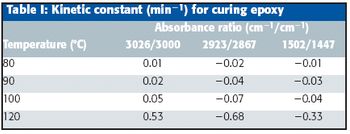
Application Notebook

Application Notebook

Application Notebook
The form and frequency of the amide I band, assigned to the C=O stretching vibration within peptide bonds, is informative and predictive of peptide or protein secondary structure. Fourier-transform infrared (FT-IR) spectroscopy analysis of protein secondary (2°) structure is particularly useful in peptide, protein, or enzyme formulation, widespread in the pharmaceutical and biofuel production industries.

Application Notebook
This September issue of The Application Notebook should be reaching our audience just as the busiest time of the year ramps up in the world of spectroscopy.

Application Notebook
Carbon black rubbers often contain multiple components, but are strongly absorbing in the infrared. The combination of Ge ATR, Advanced ATR correction and multi-component searching permits the full analysis of these important materials.

Application Notebook
The simplicity of Raman spectroscopy provides an ideal method for the quantitative determination of liquid mixtures.

Application Notebook
With gas and diesel fuel prices rising, there is an increasing need to monitor online quality control and blending mixtures. The benefits include improved accuracy in blending mixtures, solid state reliability, lifetime calibration and fraud avoidance.

Application Notebook
Some ATR / FTIR applications require a high performance, robust, and versatile accessory to accommodate difficult materials or high temperatures. As an example, the curing of a thermoset epoxy is evaluated and results are discussed.

Application Notebook
Wavelength-Scanned Cavity Ring Down Spectroscopy combines the real-time speed and turnkey simplicity of optical spectroscopy with the precision (<0.1 δ18O [‰], < 0.5 δD [‰]) previously only available from complex IRMS systems.

Application Notebook

Application Notebook
In the Life Sciences, Materials Research, and Nanotechnology, obtaining as much information as possible about the chemical and structural composition of a sample is essential. Confocal Raman Microscopy can play an important role in the nondestructive characterization and imaging of chemical properties while requiring only minimal, if any sample preparation. Systematic and routine research tasks with repetitive experiments or a large number of measurement points, as well as high-level quality control can benefit from an automated instrument.

Application Notebook
Spectral measurements down to 153 nm can be achieved easily and economically with the high-sensitivity Maya2000 Pro with Extra-Deep-UV Option. Nitrogen purging of the spectrometer helps to mitigate water and oxygen absorption in the vacuum ultraviolet.

Application Notebook
Semiconductor quantum dots (QDs) can be used as nonclassical light sources with applications in next-generation quantum communication and computing. Electrically pumped QDs are all solid-state sources of single photons that are not limited by Poisson statistics (1). Recent work by the group of Dieter Bimberg at Technische Universität-Berlin has demonstrated the selective pumping of a single InAs QD with emission from a single exciton (1–3).

Application Notebook
The factors that affect the long-term stability of ICP instruments are discussed and details of the performance of the Thermo Scientific iCAP 6000 Series for extended period analyses are given.

Application Notebook
The availability of new silicon drift detectors (SDD) allows for more precise measurements in less acquisition time. SDDs are often praised for their excellent energy resolution, but it is their increased throughput that make them ideal for many industrial applications. Due to the detector's smaller capacitance, a much shorter peaking time is used in the shaping amplifier without sacrificing resolution. This dramatically increases the throughput of the system. Compared with a conventional Si-PIN detector where the peaking time is as long as 25 ms, the drift detector operates at 1.6 ms, thereby increasing throughput from 10,000 counts per second to over 100,000. This advantage can be used in two primary ways.